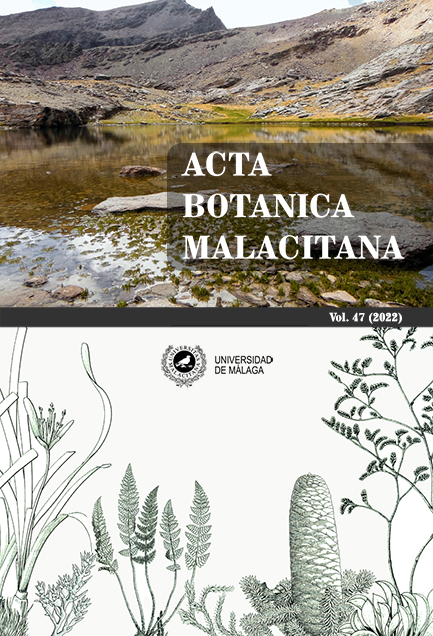Chorological novelties in the genus Veronica L. (Plantaginaceae): V. acinifolia L. for the Andalusian flora and V. peregrina var. xalapensis (Kunth) Pennell for the Iberian flora
DOI:
https://doi.org/10.24310/abm.v47i.14543Keywords:
Andalusia, Cordoba, chorology, Iberian Peninsula, Plantaginaceae, VeronicaAbstract
After reviewing herbarium material of the genus Veronica L. preserved in the COFC herbarium, we provide two chorological novelties for the regional and national flora: Veronica acinifolia L. is reported for the first time in the province of Cordoba, being also the first record of the species for the Andalusian flora, and V. peregrina var. xalapensis (Kunth) Pennell, also collected from Cordoba, is added to the Iberian flora.
Downloads
Metrics
References
Albach, D.C. (2019). Veronica L. In: Flora of North America Editorial Committee, eds. 1993+. Flora of North America North of Mexico [Online]. 22+ vols. New York and Oxford. Vol. 17. http://floranorthamerica.org/Veronica_peregrina (Accessed 22/03/2022).
Albach, D.C., Martínez-Ortega, M.M., & Chase, M.W. (2004). Veronica: parallel morphological evolution and phylogeography in the Mediterranean. Plant Systematics and Evolution, 246(3), 177-194.
Albach, D.C., Martínez-Ortega, M.M., Fischer, M.A. & Chase, M.W. (2004a). A new classification of the tribe Veroniceae—problems and a possible solution. Taxon, 53(2), 429-452.
Albach, D.C., Martínez-Ortega, M.M., Fischer, M.A. & Chase, M.W. (2004b). Evolution of Veroniceae: A phylogenetic perspective. Annals of the Missouri Botanical Garden, 91, 275-302.
Hohla, M., Diewald, W. & Király G. (2015). Limonium gmelini – eine Steppenpflanze an österreichischen Autobahnen sowie weitere Neuigkeiten zur Flora Österreichs. Stapfia, 103, 127-150.
Kaplan, Z., Danihelka, J., Št?pánková, J., Ekrt, L., Chrtek Jr., J., Zázvorka, J., Grulich, V., ?epka, R., Pran?l, J., Duchá?ek, M., Kúr, P., Šumberová, K. & Br?na, J. (2016). Distributions of vascular plants in the Czech Republic. Part 2. Preslia, 88, 229-322.
Martínez Ortega, M.M., Sánchez Agudo, J.Á. & Rico, E. (2009) Veronica. In: C. Benedí, E. Rico, J. Güemes & A. Herrero (Eds.), Flora iberica, vol. 13 (pp- 360-434). Real Jardín Botánico, CSIC, Madrid.
Pennell, F.W. (1919) Scrophulariaceae of the local flora. III. Torreya, 19(9), 161-171.
Rojas-Andrés, B.M., Padilla-García, N., de Pedro, M., López-González, N., Delgado, L., Albach, D., Castro, M., Castro, S., Loureiro, J., Martínez-Ortega, M.M. (2020). Environmental differences are correlated with the distribution pattern of cytotypes in Veronica subsection Pentasepalae at a broad scale. Annals of Botany, 125, 471-484.
Sánchez Agudo, J.Á. & Martínez Ortega, M.M. (2009). Veronica. In: G. Blanca, B. Cabezudo, M. Cueto, C. Fernández López & C. Morales Torres (Eds.), Flora Vascular de Andalucía Oriental vol. 3 (pp. 392–399). Consejería de Medio Ambiente, Junta de Andalucía, Sevilla.
Walters, S.M. & Webb, D.A. (1972) Veronica. In: T.G. Tutin, V.H. Heywood & al. (Eds.), Flora europaea vol. 3 (pp. 242-251).
Zanotti, E. (2007). Flora della pianura bresciana centro-occidentale. Vº aggionamento. Natura Bresciana, 35, 177-182.
Downloads
Published
How to Cite
Issue
Section
License
All information related to the licensing of published works in Acta Botanica Malacitana and copyright can be found in our Editorial Policy.







1.png)
